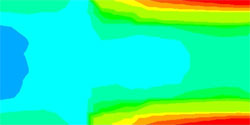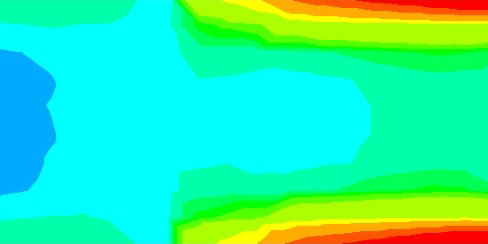Fluid Pump without Moving Parts
Microscopic pipes could soon move fluid around in a chemical-analysis chip or transport coolant around hot electronic circuits. In the 22 October Physical Review Letters, a team from Hong Kong proposes a new type of fluid channel made of sections with different surface properties. Their computer simulations show that heating at the seam joining the two sections could drive fluid flow in one direction, perhaps fast enough to cool computer chips using their own heat.
The techniques used to craft semiconductor chips can also be used to make tiny tubes for transporting liquid. At nanometer dimensions, though, fluid flow differs markedly from that at familiar scales. One big difference is that interactions between the liquid and the walls of the channel become much more important. Over the years, researchers have proposed many ways to modify surface properties to manipulate fluid flow in channels without moving parts. But most of these schemes cannot easily move fluid in a complete circuit–for example, fluid might flow from hot to cold but not back, as would be required for cooling.
Chong Liu and Zhigang Li of Hong Kong University of Science and Technology previously explored flow through nanometer-scale channels using molecular dynamics simulations, which account for the motion of each molecule in response to various forces. They varied the attraction between the liquid and the wall, the same property that determines whether a large liquid drop “wets” a surface or beads up [1]. The combination of surface properties and temperature had dramatic effects on the flow.
“That inspired us to develop a composite channel,” Li says, made of two sections with different surface properties. The channel was oriented to move fluid left-to-right or right-to-left. In the left section, the surface attraction was low, and they expected the simulated fluid to flow from hot areas to cold. Li explains that heat creates a pressure that pushes the fluid toward colder areas. In the right section, the surface attraction was high, and they expected the fluid to flow from cold to hot. Li says the wall becomes even stickier at lower temperatures, which increases the density near the wall and for several molecular layers into the tiny channel. The higher density increases the pressure and pushes the fluid toward warmer, less-sticky regions.
In their simulation, the researchers made the temperature in the center hundreds of degrees hotter than at the ends. This drove the fluid in both sections to the left: toward the hot center on the right side and toward the cold end on the left. Li says that the estimated flow velocity may be high enough to be useful for cooling computer chips without moving parts. But since the effect depends on surface properties, it will only work for channels 20 nanometers or less in width.
German Drazer of Johns Hopkins University in Baltimore finds the work “intriguing” and says that molecular dynamics is important because researchers don’t know for sure how to describe fluid flow immediately adjacent to surfaces. In traditional calculations, he says, “some of the physics you have to put in by hand.”
–Don Monroe
Don Monroe is a freelance science writer in Murray Hill, New Jersey.
References
- C. Liu and Z. Li, “Flow Regimes and Parameter Dependence in Nanochannel Flows,” Phys. Rev. E 80, 036302 (2009)





